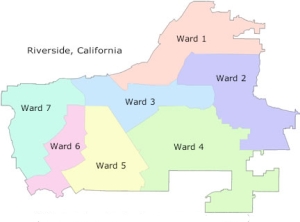Chamber to Analyze Effects of Redrawing City Wards

With significant growth in the City of Riverside since the 2000 Census, the City Council will soon begin reshaping ward boundaries to ensure that each ward contains a substantially equal number of residents.
Fresh off the recent run-off election for Ward 7 this past November, the Riverside City Council will soon begin redrawing their ward boundaries to reflect the growth in the City of Riverside and shifts in population among the seven wards. The resulting changes will likely have lasting impacts on future municipal governance in the City and ensure that representation reflects the growth of residents and businesses in the community. The Chamber will monitor the process to ensure that the business community is well-represented in any changes to the ward boundaries.
The Riverside City Charter provides that the boundaries of wards shall be reviewed at least every ten years after the completion of the federal census and that the boundaries of each ward shall contain a substantially equal number of residents. The Riverside City Charter states that the boundaries of each ward shall include a substantially equal number of residents and new boundaries cannot effectively cut a Councilmember out of their ward during their elected term. According to the 2010 Census, the population of the City of Riverside is 303,864 residents, demonstrating a marked growth from the 2000 census total of 255,166. Therefore, under optimal conditions, each city ward should contain 43,409 residents.
Following the redistricting process undertaken in 2002, the City Council adopted a set of criteria for developing new boundaries including: 1) equalizing the population count in each ward within 10%; 2) achieving within 5% from optimal population per ward; 3) complying with all applicable laws; 4) avoiding disqualification of City Councilmembers during a term; 5) maintaining continuity of existing wards to the extent possible; 6) drawing wards that are compact and contiguous; 7) using natural geographic boundaries to the extent possible; 8) maintaining cohesive neighborhoods and community interests to the extent possible; 9) considering school districts and avoiding division to the extent possible; and 10) maintaining income diversity within wards to the extent possible.
The City Council’s Governmental Affairs Committee will begin public meetings and deliberations of alternatives in March 2012 with the intention of introducing and adopting an ordinance to amend ward boundaries in June 2012.